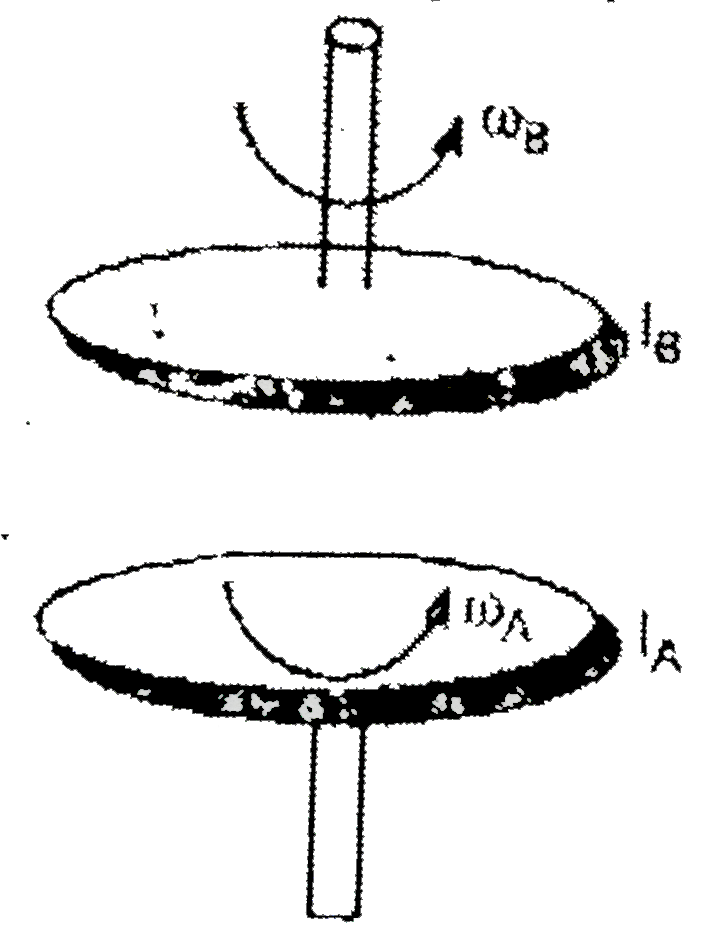In the above question disc B is brought in contact with disc A, they acquire a common angular velocity in time t. The average frictional torque on one disc by the other during this period is :
2Iω3t
9Iω2t
9Iω4t
3Iω2t
The correct Answer is:A
Let ω. be the angular velocity when the two discs get combined. Then by conservation of angular momentum,
(I+2I)ω.=I×2ω+2Iω
or ω.=4ω3 ...(i)
Now ω.=ω+at=ω+τ2I×t (where τ is the average frictional torque)
or 4ω3−ω=τ2I.t
τ=2Iω3t
Topper's Solved these Questions
- ROTATIONAL MOTIONBOOK - MODERN PUBLICATIONCHAPTER - ROTATIONAL MOTIONEXERCISE - LEVEL-III (MCQ)
10 Videos
- ROTATIONAL MOTIONBOOK - MODERN PUBLICATIONCHAPTER - ROTATIONAL MOTIONEXERCISE - RCQ
8 Videos
- ROTATIONAL MOTIONBOOK - MODERN PUBLICATIONCHAPTER - ROTATIONAL MOTIONEXERCISE - RCQ
8 Videos
- RAY OPTICSBOOK - MODERN PUBLICATIONCHAPTER - RAY OPTICSEXERCISE - RECENT COMPETITIVE QUESTION
32 Videos
- SOLIDS & SEMICONDUCTOR DEVICESBOOK - MODERN PUBLICATIONCHAPTER - SOLIDS & SEMICONDUCTOR DEVICESEXERCISE - Revision Test
28 Videos
Similar Questions
Two discs A and B are mounted coaxiallay on a vertical axle. The discs have moments of inertia I and 2 I respectively about the common axis. Disc A is imparted an initial angular velocity 2ω using the entire potential energy of a spring compressed by a distance x1 Disc B is imparted an angular velocity ω by a spring having the same spring constant and compressed by a distance x2 Both the discs rotate in the clockwise direction.
When disc B is brought in contact with disc A, they acquire a common angular velocity in time t. The average frictional torque on one disc by the other during this period is
View SolutionA clutch assembly consists of two discs A and B of moment of inertia 2I and I respectively, one being the engine fly wheel, the other one is the clutch plate. The discs are initially rotaing with angular velocities ωA=ω and ωB=2ω as shown in fig. When the two disc are brought into contact the discs rub against each other and eventually reach a common angualr velocity ω.
(a) Derive an expressio for ω
(b) What is the angular impulse of friction on any one of the discs?

View Solution
Knowledge Check
In the above question disc B is brought in contact with disc A, they acquire a common angular velocity in time t. The average frictional torque on one disc by the other during this periodis:
A2Iω3tB9Iω2tC9Iω4tD3Iω2tTwo discs A and B are mounted coaxiallay on a vertical axle. The discs have moments of inertia I and 2 I respectively about the common axis. Disc A is imparted an initial angular velocity 2ω using the entire potential energy of a spring compressed by a distance x1 Disc B is imparted an angular velocity ω by a spring having the same spring constant and compressed by a distance x2 Both the discs rotate in the clockwise direction.
When disc B is brought in contact with disc A, they acquire a common angular velocity in time t. The average frictional torque on one disc by the other during this period isA2Iω3tB9Iω2tC9Iω4tD3Iω2tTwo discs A and B are mounted coaxially ona vertical axle. The discs have moments of inertia l and 2l respectively about the common axis. Disc A is imparted an initial angular velocity 2ω using the centre potential energy of a spring compressed by a distance x1. Disc B is imparted angular velocity ω by a spring having the same spring constant and compressed by a distance x2. Both the disc rotate in the clockwise direction.
When disc B is brought in contact with disc A, they acquirea common angularvelocity in time t. The average frictional torque on one disc by the other during this period is -A2Iω3tB9Iω3tC9Iω4tD9Iω2t
In the above question, if the disc executes rotatory motion, its angular acceleration will be:
View SolutionDiscs A and B are mounted on a shaft SS and may be connected or disconnected by a clutch C. The moment of inertia of disc A is one half that of disc B. With the clutch disconnected, A is brought up to an angular velocity ω0 .The accelerating torque is then removed from A and it is coupled to disc B by the clutch (Bearing friction may be neglected). It is found that 2000J of heat is developed in the clutch when the connection is made. What is the original kinetic energy of disc A?
View SolutionDiscs A and B are mounted on a shaft SS and may be connected or disconnected by a clutch C. The moment of inertia of disc A is one half that of disc B. With the clutch disconnected, A is brought up to an angular velocity ω0 .The accelerating torque is then removed from A and it is coupled to disc B by the clutch (Bearing friction may be neglected). It is found that 2000J of heat is developed in the clutch when the connection is made. What is the original kinetic energy of disc A?
View SolutionIn the above question, if the disc executes rotatory motion, its angular acceleration will be:
View SolutionIn the above question, if the disc executes rotatory motion, its angular acceleration will be :-
View Solution
